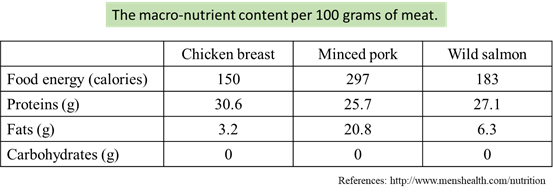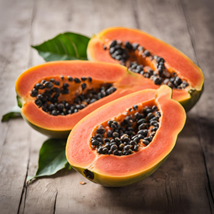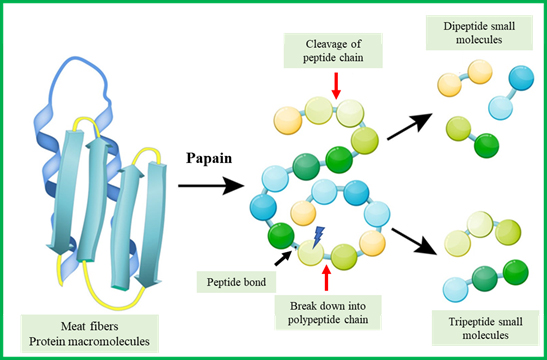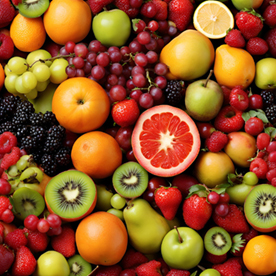Exploring the Chemistry of Meat Tenderizer
Introduction
During the COVID-19 pandemic, my siblings and I brought our 94-year-old mother to live with me for better care. She's generally healthy and self-sufficient, but she has had no natural teeth since her sixties, and her receding gums make her dentures loose, complicating eating. My wife and I, now in our seventies, must learn how to select and prepare suitable foods for her dental issues—a skill that will soon be relevant to us too.
The importance of protein
Due to her limited dental function, my mother's appetite has decreased. However, we need to consume enough protein to maintain effective physiological functions, which is especially important for the elderly. Chicken, fish, and pork all contain high-quality protein, providing all the essential amino acids necessary for the body to produce the nutrients needed for muscle synthesis. A protein deficiency in the elderly can cause sarcopenia, which may result in severe muscle deterioration and impaired mobility. Both fish and meat are excellent and cost-effective protein options to restore muscle mass. The following table details their macronutrient profiles.

The three foods listed above are low in calories and have zero carbohydrates, which means they can be consumed in large quantities without the risk of weight gain. For those who are cautious about fat intake, lean meat is a good alternative since minced pork is known for its higher fat levels. It's well-known that wild salmon is rich in unsaturated fatty acids, including Omega 3, which are beneficial for lowering bad cholesterol and supporting heart health. Therefore, wild salmon is a good food choice for the elderly. These three foods are also rich in micronutrients including vitamins and minerals, contributing to a balanced diet. The Institute of Medicine recommends that proteins make up 10-35% of our daily calories and aiming for 20-30 grams of meat per meal is ideal for preserving muscle strength and function.
Food preparation
Sometimes, nutritious meals can be unappetizing. Chicken and pork are tougher than fish, which doesn't suit my mother due to her dental problems. Convincing her to eat a little bit of these meats is often a challenge. Looking for a solution, I found a bottle of "meat tenderizer" in the kitchen. As a chemist, I was excited to investigate how this ingredient works to soften meat.
Restaurants and markets have been widely using "meat tenderizer" to marinate commonly used meats such as pork, beef, and chicken. Meat treated with tenderizer is notably softer, enhancing its chewability and digestibility. Curious about the science behind this, I turned to Microsoft's latest Copilot data search tool. Within 30 seconds, I had a clear explanation about meat tenderizer:
Meat tenderizer is a seasoning used for marinating meat. It is somewhat similar to baking soda, but also has its differences.
- Baking soda is an alkaline powder that reacts with the proteins in meat. It softens the tissue structure of meat and reduces the loss of meat juices. However, baking soda can make the texture of the meat extremely soft thus affecting the texture. Baking soda will also produce an alkaline taste and lead to loss of nutrients.
- Meat tenderizer, on the other hand, is made from papain enzymes from papaya and other quality ingredients. Marinating meat with meat tenderizer not only makes the meat tender and juicy but also retains the meat's own flavor.
If you want to try marinating meat, you might consider using meat tenderizer, as it maintains the quality of the meat without affecting the taste and nutrition.
The source and function of meat tenderizer
The chemical formula of baking soda is sodium bicarbonate (NaHCO3). It is a commonly used mild alkaline chemical reagent in food preparation. When baking soda is added to meat, it reacts with the amino (-NH2) and carboxyl (-COOH) groups in meat protein, altering their tertiary structure. This rearrangement of hydrophilic and hydrophobic regions leads to a relaxation of the meat's tissue and an enhanced ability to retain water, effectively tenderizing the meat. Meat tenderizers often contain active biochemicals like proteases, which are typically extracted from fruits such as papaya, kiwi, and pineapple. For example, papain is an enzyme extracted from papaya. It consists of 212 amino acid residues linked by three pairs of disulfide bonds [-S-S-], which connect different amino acid chains.

Figure 1: Papain is a cysteine protease consisting of 212 amino acid residues
Papain's catalytic activity is enabled by an active site formed by a cavity involving cysteine (Cys-25), histidine (His-159), and asparagine (Asn-158). This site acts like a net, drawing the active portion of the protein substrate into the cavity and securing the peptide bonds of the meat's protein substrates in a precise "key and lock" mechanism. Through the action of catalytic triad, papain works like scissors, cutting through the tough protein fibers in meat. Papain cleaves the large protein structures into smaller peptide chains, including dipeptides and tripeptides. This process not only softens the meat but also make the meat easier to digest. Enzymes like papain are essential ingredients in meat tenderizing powders that are readily available in supermarket. Due to their proven efficacy, there has been an increase in the availability of food supplements featuring papain in the marketplace.1

Figure 2: A schematic representation of the breakdown of meat fiber by papain.
When we consume food, various parts of our digestive system, such as the mouth, stomach, small intestine, and pancreas, release enzymes that methodically break down complex proteins, carbohydrates, and fats. This process aids in the absorption of essential nutrients.2 However, with the decline in digestive efficiency often seen in older adults, the benefits of incorporating meat tenderizers into food preparation become particularly noticeable. Hong Kong-style café (Cha chaan teng), aiming to keep costs down, usually select the more economical choices. They frequently choose for leaner, frozen beef steaks and pork chops because they are less expensive. These cuts tend to be less juicy and more fibrous when cooked. However, by applying a meat tenderizer beforehand, even the tougher cuts can be transformed into pleasantly tender meals that are a delight to eat.

Figure 3: Kiwi, pear, pineapple, and papaya are fruits rich in enzymes.
The challenge of the master chef
When making meals at home, you can skip the store-bought meat tenderizer and instead use enzyme-rich fruits like kiwi, pear, pineapple, and papaya. Blend these fruits and soak the meat in it for 15 to 20 minutes. This method not only imparts a subtle fruity scent that can boost the taste of the meat but also preserves the full nutritional value of the fresh fruits.3 If you take pleasure in cooking and often consider yourself a ‘master chef’, why not experiment with fresh fruits and pork tenderloin? Use your imagination to create a dish that is both nourishing and gentle on the stomach, catering especially to those with 'silver hair'.
References
- Goodrx: Can Papaya Enzyme Help You Digest Faster? A Look at the Possible Benefits and Side Effects. https://www.goodrx.com/well-being/gut-health/papaya-enzyme-benefits
- Britannica: Fats. https://www.britannica.com/science/human-digestive-system/Fats
- UFood. https://food.ulifestyle.com.hk/recipe/detail/3103820
By Prof. Chan W. H.
Translate by Dr. Yim K. H.